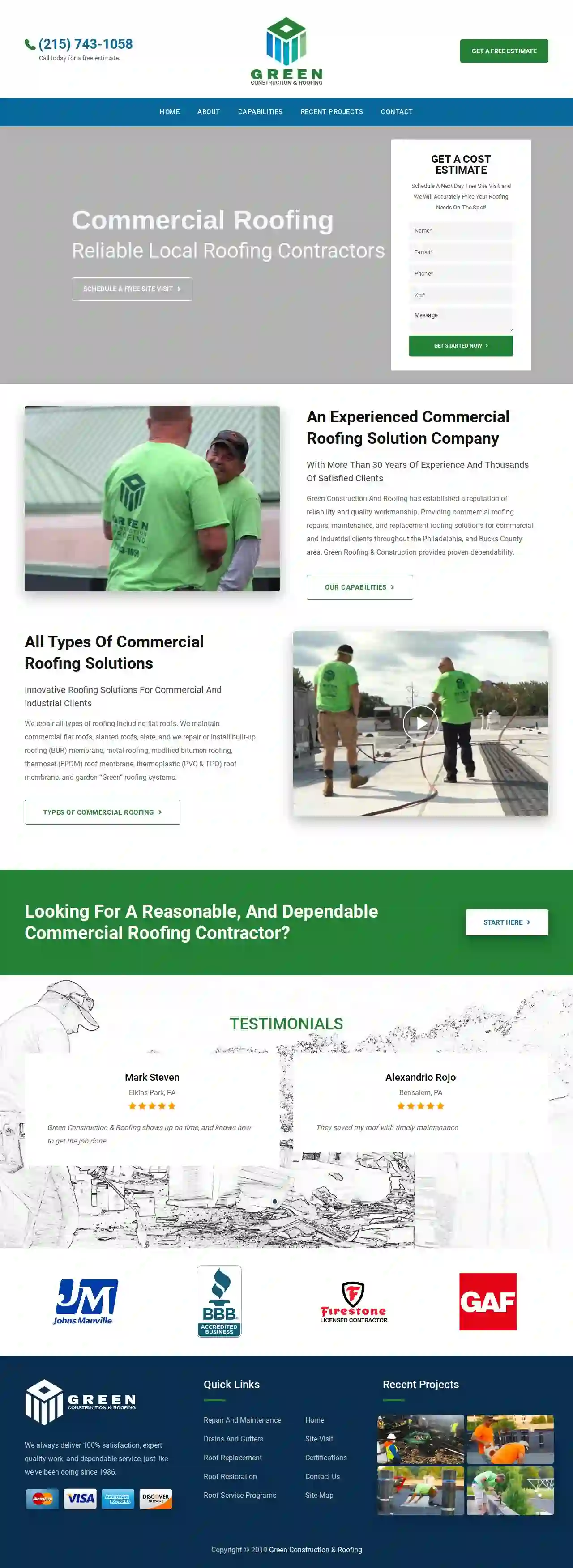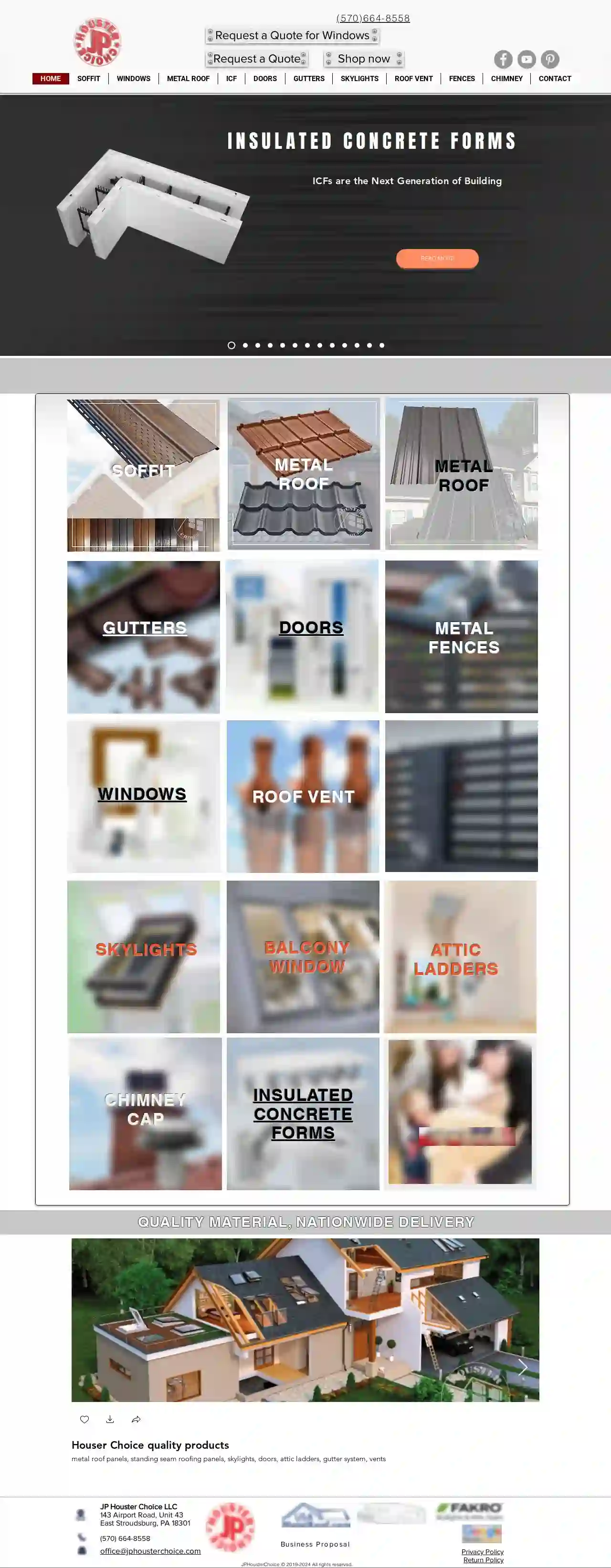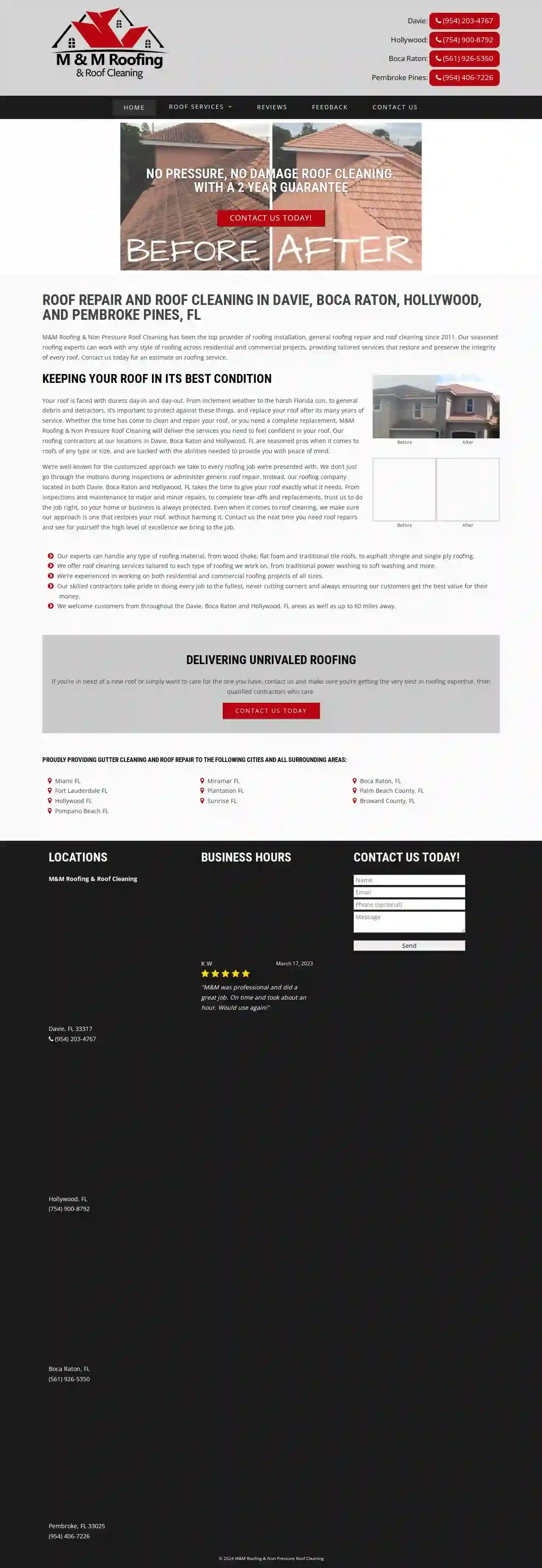Roofing Companies Spring House
Find Roofing Service in Spring House
Receive 3 FREE Roofing Services quotes for your project today! Compare profiles, reviews, accreditations, portfolio, etc... and choose the best service.

Bronson Roofing
521 reviews20 Willow Avenue, Oakdale, 15071, USWe are Bronson Roofing Inc., a family-owned and operated roofing company serving the Oakdale, Pennsylvania area. With years of experience, we pride ourselves on providing high-quality roofing services, from repairs to new installations. We are committed to using the best materials and techniques to ensure your roof is protected and looks its best. Our team of skilled professionals is dedicated to providing excellent customer service and exceeding your expectations. We are a certified GAF contractor, which means you can trust us to install your roof to the highest industry standards. We offer a variety of roofing services, including roof cleaning, flashing repair, emergency repairs, new roof installations, and siding repairs. We also offer a GAF System Plus Warranty, which provides comprehensive coverage against manufacturing defects. Contact us today for a free quote and let us help you with all your roofing needs.
- Services
- Why Us?
- Accreditations
- Our Team
- Testimonials
- Gallery
Get Quote
Pergola Roof
3.848 reviews85 Broad St, fl 18, New York, 10004, USPergola Roof offers high-end retractable canopies, louvers, sunrooms, screens, and glass systems to transform your outdoor living space. Our aluminum structure systems are designed to make the most of your patio, terrace, and backyard year-round. We provide lasting and aesthetic solutions that are perfect for any space. Our features include all-season use, dimmable LED lights, blackout or translucent options, remote control functionality, watertight construction, and weather resistance. Pergola Roof is committed to creating unique and functional outdoor living spaces that enhance your lifestyle.
- Services
- Why Us?
- Gallery
Get Quote
Roofing and Construction Corp.
4.69 reviews1111 SW 21st Ave B18, Ft. Lauderdale, 33312, USRoofing and Construction Corp. is your premier source for residential and commercial roofing solutions in Fort Lauderdale, Florida. As a family-owned and operated business, we prioritize our clients' satisfaction and budget, offering assistance with financing and direct communication with the owner. We are fully licensed and insured (CCC1328459 CGC 1518547) and take pride in our commitment to quality craftsmanship and exceptional customer service. Our team of experienced roofing contractors specializes in a wide range of services, including roof replacement, reroofing, repair, and maintenance for both residential and commercial properties. We utilize the highest quality materials and techniques to ensure durability, enhance aesthetics, and protect your investment. We are also proud to be awarded the FRSA Safety Award and are My Safe Florida Home certified and accredited by the Better Business Bureau, providing you with peace of mind knowing you're working with a trusted and reliable team.
- Services
- Why Us?
- Accreditations
- Gallery
Get Quote
Green Construction & Roofing
Philadelphia, USGreen Construction & Roofing has established a reputation of reliability and quality workmanship. Providing commercial roofing repairs, maintenance, and replacement roofing solutions for commercial and industrial clients throughout the Philadelphia, and Bucks County area, Green Roofing & Construction provides proven dependability. With more than 30 years of experience and thousands of satisfied clients, we are an experienced commercial roofing solution company. We repair all types of roofing including flat roofs. We maintain commercial flat roofs, slanted roofs, slate, and we repair or install built-up roofing (BUR) membrane, metal roofing, modified bitumen roofing, thermoset (EPDM) roof membrane, thermoplastic (PVC & TPO) roof membrane, and garden “Green” roofing systems.
- Services
- Why Us?
- Testimonials
- Gallery
Get Quote
Pittsburgh Metal Roofing
Pittsburgh, USAt Pittsburgh Metal Roofing Co., we're the area's foremost authority on metal roofing. We have extensive knowledge and experience in our industry, and no team in the business is more dedicated to your satisfaction. If you're having a new home or business built or planning to upgrade your existing roof, feel free to contact us for an estimate. Protecting your business or home and everything inside it is essential. At Pittsburgh Metal Roofing Co., we understand how important your roofing is to this process. Call us or contact us using the form on our website to schedule a consultation. From there, we'll help you enjoy all the benefits metal roofing and an expert installation company can bring you.
- Services
- Why Us?
- Gallery
Get Quote
Houster Choice - Metal Roof Certified Contractor
526 reviews143 Airport Road, Unit 43, East Stroudsburg, 18301, USHouser Choice quality products metal roof panels, standing seam roofing panels, skylights, doors, attic ladders, gutter system, vents. For proven strength and performance, the Fox Blocks Series is the basis for successful foundations, walls and buildings. JPHouster Choice LLC is located at 143 Airport Road, Unit 43, East Stroudsburg, PA 18301 and can be contacted at (570) 664-8558 or [email protected].
- Services
- Why Us?
- Gallery
Get Quote
CentiMark Commercial Roofing
4.615 reviews12 Grandview Cir, Canonsburg, 15317, USLeading Commercial Roofing Contractor With over 100 office locations and more than 650 roofing crews, we have been providing dependable commercial roofing solutions to North America since 1968. START YOUR ROOFING PROJECT Commercial Roof Systems and Services Out of sight, out of mind, minor roof damage caused by inclement weather or aging may stay hidden until it becomes a visible leak. A single roof leak can cause havoc to your regular business operations, damage your equipment and inventory and put your employees at risk. Stay ahead of roof leaks by maintaining your commercial roof in its best shape possible. From comprehensive roof evaluations and repairs done right to maintenance plans and reroofing, we are just a call away and ready to help you with your custom roofing needs. Explore the commercial roofing systems we install like TPO, EPDM, SPF, metal, etc. and see all the roofing services we offer. Dealing With Commercial Roofing Issues? If you are facing roof leaks or other issues with your facility's roof, you have multiple options to address them. Learn how we can work together to keep your building watertight. ALL SERVICES Managing multiple buildings? Check out our programs for nationwide and global companies. Portfolio Management >> Preventative roof maintenance is a key to keep your roof healthy and catching any issues early. Roof Maintenance >> Timely repairs help extends your roof's life. Let's get it done right the first time! Roof Repair >> When is it time to replace your existing commercial roof? Our roofing specialists are here to help you decide whether to repair or reroof. Reroofing >> Why Partner With CentiMark? Our mission is to keep your building watertight, protect your property and employees all in concert with regular business operations. With over 100 locations across North America, we provide customized roofing solutions for all your needs with unparalleled workmanship and attention to the details, safety and the needs of our customers all backed by our Single Source Warranty. Contact us today to get started on your next roofing project. Whether your facility has a flat roof, a steep slope roof or a combination of both, whether you manage a single commercial building or a portfolio of properties, our team is here to assist you with roof repairs, maintenance, replacement and any other roofing needs. From coast to coast, we pledge to deliver consistent results with minimal to zero interruptions to your business operations. OUR CAPABILITIES 650+ Commercial Roofing Crews at Your Service
- Services
- Why Us?
- Accreditations
- Our Team
- Testimonials
- Gallery
Get Quote
Clark Roofing Co.
3.724 reviewsPhiladelphia, US- Services
- Why Us?
- Gallery
Get Quote
Hassler Roofing Inc.
4.9158 reviewsAllentown, USHassler Roofing, Inc. is a GAF Master Elite contractor serving the greater Philadelphia area. We are a family-owned and operated business with over 20 years of experience in the roofing industry. We specialize in roof replacements and seamless gutters. We are fully insured and licensed. Hassler Roofing, Inc. is committed to providing our customers with the highest quality workmanship and customer service. We offer free estimates and financing options are available.
- Services
- Why Us?
- Accreditations
- Gallery
Get Quote
M&M Roofing & Roof Cleaning
4.528 reviewsM&M Roofing & Non Pressure Roof Cleaning, Davie, FL, 33317, USM&M Roofing & Non Pressure Roof Cleaning has been the top provider of roofing installation, general roofing repair and roof cleaning since 2011. Our seasoned roofing experts can work with any style of roofing across residential and commercial projects, providing tailored services that restore and preserve the integrity of every roof. Contact us today for an estimate on roofing service.
- Services
- Why Us?
- Testimonials
- Gallery
Get Quote
Over 17,196+ Roofing Businesses registered
Our roofing pros operate in Spring House and surroundings!
Roofyng.com has curated and vetted the Best Roofing Companies near Spring House. Find the most trustworthy contractor today.
Frequently Asked Questions About Roofing Companies
- Hot Climates: Opt for light-colored or reflective roofing materials to reduce heat absorption. Consider tile roofs for their thermal mass and heat resistance.
- Cold Climates: Ensure your roof has adequate insulation and ventilation to prevent ice dams and moisture buildup. Metal roofs can shed snow effectively.
- High-Wind Areas: Choose roofing systems with high wind ratings and properly installed hurricane straps or clips to enhance wind resistance.
- Areas with Heavy Rainfall: Ensure your roof has proper drainage and a waterproof membrane to prevent leaks.
- Listed Buildings: Buildings with historical or architectural significance.
- Conservation Areas: Areas with special architectural or historical character.
- Changes to Roof Design: If you're making significant alterations to the roof's design, such as adding a dormer window or changing the pitch.
- Regular Inspections: Inspect your roof at least twice a year for signs of damage or wear and tear.
- Gutter Cleaning: Clean gutters and downspouts regularly to prevent clogs and ensure proper drainage.
- Tree Trimming: Trim overhanging branches to avoid damage from falling debris and reduce shade, preventing moss growth.
- Proper Ventilation: Ensure good attic ventilation to regulate temperature and moisture.
- Timely Repairs: Address any damage promptly to prevent escalation.
How do I choose the right type of roof for my climate?
Do I need planning permission to replace my roof in the USA?
How do I prevent roof damage?
What is the difference between a roof overlay and a roof tear-off?
Roof Overlay: Installing a new layer of roofing material over the existing roof. It's less expensive and faster, but not always ideal.
Roof Tear-Off: Completely removing the existing roofing before installing a new one. More labor-intensive but allows for inspection and repairs to the roof deck.
A tear-off is typically preferred, but a roofing contractor can advise on the best approach for your situation.
How do I choose the right type of roof for my climate?
- Hot Climates: Opt for light-colored or reflective roofing materials to reduce heat absorption. Consider tile roofs for their thermal mass and heat resistance.
- Cold Climates: Ensure your roof has adequate insulation and ventilation to prevent ice dams and moisture buildup. Metal roofs can shed snow effectively.
- High-Wind Areas: Choose roofing systems with high wind ratings and properly installed hurricane straps or clips to enhance wind resistance.
- Areas with Heavy Rainfall: Ensure your roof has proper drainage and a waterproof membrane to prevent leaks.
Do I need planning permission to replace my roof in the USA?
- Listed Buildings: Buildings with historical or architectural significance.
- Conservation Areas: Areas with special architectural or historical character.
- Changes to Roof Design: If you're making significant alterations to the roof's design, such as adding a dormer window or changing the pitch.
How do I prevent roof damage?
- Regular Inspections: Inspect your roof at least twice a year for signs of damage or wear and tear.
- Gutter Cleaning: Clean gutters and downspouts regularly to prevent clogs and ensure proper drainage.
- Tree Trimming: Trim overhanging branches to avoid damage from falling debris and reduce shade, preventing moss growth.
- Proper Ventilation: Ensure good attic ventilation to regulate temperature and moisture.
- Timely Repairs: Address any damage promptly to prevent escalation.
What is the difference between a roof overlay and a roof tear-off?
Roof Overlay: Installing a new layer of roofing material over the existing roof. It's less expensive and faster, but not always ideal.
Roof Tear-Off: Completely removing the existing roofing before installing a new one. More labor-intensive but allows for inspection and repairs to the roof deck.
A tear-off is typically preferred, but a roofing contractor can advise on the best approach for your situation.